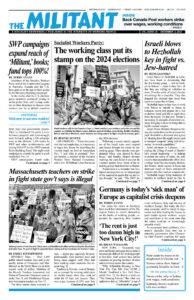Russian President Vladimir Putin has stepped up the pace of his invading forces’ drive to seize more territory in the Donetsk region of Ukraine through “meat wave” frontal assaults. The Ukrainian defenders, stretched and outgunned but motivated and determined to defend the sovereignty of their country, are inflicting the heaviest losses of the war on Moscow’s troops.
Part of Putin’s motivation is President-elect Donald Trump’s stated aim to use Washington’s substantial if declining weight in world politics to press the two sides into talks to end hostilities.
The U.S. rulers have sought to keep their options open to best advance their own strategic interests in the region by providing Kyiv with just enough arms to forestall defeat, but not enough to win. In mid-November, the outgoing Joseph Biden administration eased its limits on Kyiv using long-range U.S. missiles against military targets on Russian territory, after a year’s hesitation. But this only applies in the Kursk region of western Russia, where Kyiv made an incursion and has held most of the ground it seized.
A counteroffensive by 40,000 Russian troops, reinforced by some 10,000 North Korean soldiers, is trying to dislodge Kyiv’s forces there. The Ukrainian-held Russian terrain would be a lever for Kyiv in any negotiations over Moscow’s occupation of 18% of Ukraine’s territory.
In its ongoing effort to target civilians, Moscow launched 120 missiles and 90 drones against Ukrainian cities Nov. 16-17. The majority were shot down but the airstrikes killed at least seven people and severely damaged parts of Ukraine’s already weakened electrical system.
The tactics of the Russian army brass in Kursk and on the front in southeastern Ukraine are now costing 1,500 to 2,000 troops killed and severely wounded a day. There have been over 700,000 Russian casualties since Putin’s invasion began in February 2022.
Russian marines suffered disastrous losses from their first attempt to retake the settlement of Novoivanovka from Kyiv’s forces in Kursk. But their commanders stubbornly continued the same type of assault another five times. Losses surged into the hundreds as Ukrainian defenders knew exactly what to expect.
According to a Nov. 16 Euromaidan report, the riverbanks near the township’s only bridge were “littered with dead Russian soldiers and destroyed armored vehicles.” Other elite Russian forces elsewhere have also suffered sizable losses at the hands of tenacious Ukrainian defenders.
Russian soldiers’ relatives protest
Although anti-war protesters now face immediate arrest in Russia, some 20 wives, mothers and daughters of mobilized conscripts protested outside the Ministry of Defense building in Moscow Sept. 21, the second anniversary of Putin’s unpopular mass draft. They insisted Russian Defense Minister Andrei Belousov meet their demand that mobilized reservists, who have spent two years at the front, be brought home.
Paid provocateurs showed up to disrupt the protest. One pro-Kremlin woman got in a protester’s face, telling her to “stay home and pray.” The provocateurs “insulted the wives and mothers,” baiting them as “foreign agents,” reported Russian opposition outlet Mobilization News.
But they couldn’t rattle the soldiers’ family members, so police intervened and “shamefully detained the mobilized men’s relatives.” Two reporters for the independent news outlet SOTAvision were also held for several hours and warned that the women’s protests should not be covered.
The women have been released, a statement in Mobilization News said, “but this shame cannot be erased from history. The authorities took the men away and are now at war with their wives, mothers and daughters.”
In September 2022 Putin launched his unpopular “partial mobilization” to draft 300,000 civilians for the war. Mass protests erupted across the Russian Federation and hundreds of thousands of young men fled the country.
Despite the heavy casualties, Putin has not called up new mobilizations. He fears this would set off open opposition to his regime’s war among working people and the oppressed nationalities of the Russian Federation who bear the brunt of Russian losses. These Russian toilers are the most important ally of the Ukrainian people.
Chanting “No to war!” and “Russia without Putin!” and carrying banners saying “Ukraine’s victory is also ours!” several thousand Russians and supporters marched in Berlin Nov. 17. Organizers included Yulia Navalnaya, the widow of late opposition figure Alexei Navalny, as well as former political prisoners Ilya Yashin, Vladimir Kara-Murza and Oleg Orlov, all of whom were released Aug. 1 in a prisoner swap. They aim to deepen the opposition of Russians to Putin’s war.
The protest demanded the complete withdrawal of Russian troops from Ukraine and the release of all political prisoners by Moscow.
Similar rallies were held in London, Amsterdam, Warsaw, Vienna and elsewhere.


